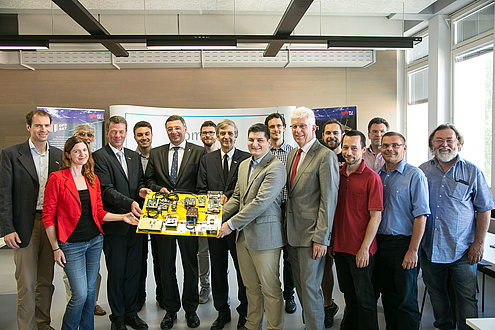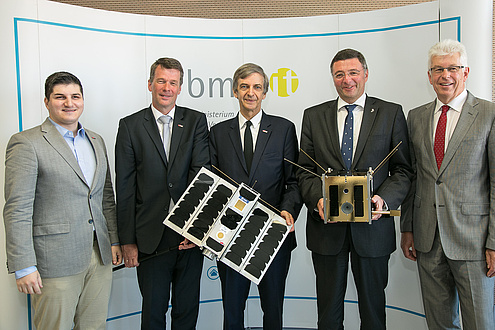New technology in space
“With our first satellite – TUGSAT-1 – we could impressively show that demanding scientific and technological tasks could be carried out reliably. Our new missions will bring exciting technical challenges to bear which will put TU Graz on the international map,” says project leader Otto Koudelka, head of the Institute of Communication Networks and Satellite Communications at TU Graz. CubeSat PRETTY has been fitted out with a system for so-called passive reflectometry, among other things, which allows for measurements of height to be carried out in the decimetre and centimetre range, reports Otto Koudelka. PRETTY should be launched into space in 2020 and will circle the Earth in a polar orbit at about 600 kilometres in height. As with all running satellite projects, budding TU Graz researchers are also highly integrated in all project areas in this new mission.According to Horst Bischof, Vice Rector for Research at TU Graz, a tight network with big national players and local infrastructure contribute to the success of space uni TU Graz. “We work very closely with the Space Research Institute of the Austrian Academy of Sciences, we’ve got the Lustbühel Observatory – an internationally recognised measuring station for space projects of all kinds, we operate the ground station for the international satellite mission BRITE at the TU Graz Campus, and we’ve had several Austrian pioneers of space research such as Willibald Riedler, Hans Sünkel, Wolfgang Baumjohan and not least Otto Koudelka. Austria, in particular Graz, is today without doubt an international visible centre of space research.”
Premium class satellite builder
Triple-CubeSat PRETTY is the fifth red-white-red satellite in space, and the third to emerge from the labs of TU Graz. TUGSAT-1, the first ever Austro-satellite, has been on its successful space journey for more than four years, and along with its twin satellite – UniBRITE – from the University of Vienna, is measuring the variability of stellar brightness. OPS-SAT, which was also developed at TU Graz on behalf of ESA, will be launched in the coming year. It has new space software on board which will test new communication technologies for future space missions, among other things, and will be on the lookout for sources of interference for space radio communication.“With the new ESA contract, Austria has finally arrived in the premium class of satellite builders,” says the delighted space minister, Jörg Leichtfried, on the occasion of a press conference at TU Graz. Klaus Pseiner, the vice-chair of the Council of the European Space Agency is also convinced of the potential for small and very small satellites to bring space research a good deal further. “Compact satellites allow new space technologies to be tried out relatively quickly and cheaply,” explains Pseiner.
The Federal Ministry for Transport, Innovation and Technology invests some 70 million euros annually in the space sector. The space ministry passed on some 2.5 million euros it received from ESA for the new CubeSat. Austria co-finances ESA programmes thus allowing Austrian companies to apply for orders in the framework of ESA missions. About 120 Austrian companies and organisations with more than 1000 employees are involved in the space industry. The overall turnover in the sector is some 125 million euros per year.
Space research at TU Graz is mostly anchored in the Field of Expertise “Information, Communication & Computing”.
![[Translate to Englisch:] © FFG/Morgenstern [Translate to Englisch:] Drei Männer und eine Frau halten beziehungsweise betrachten den Kleinsatelliten OPSSAT.](https://www.tugraz.at/fileadmin/_processed_/b/d/csm_PK_PRETTY_by_FFG_Morgenstern2_web_3c59dea729.jpg)


